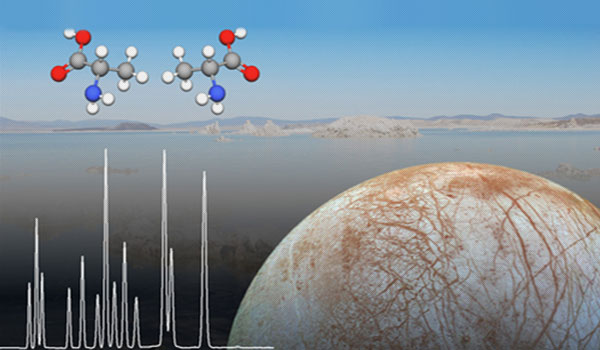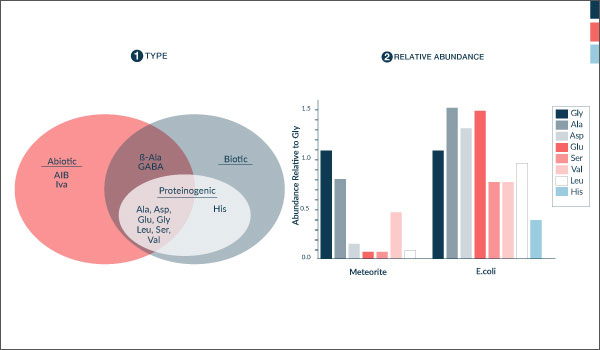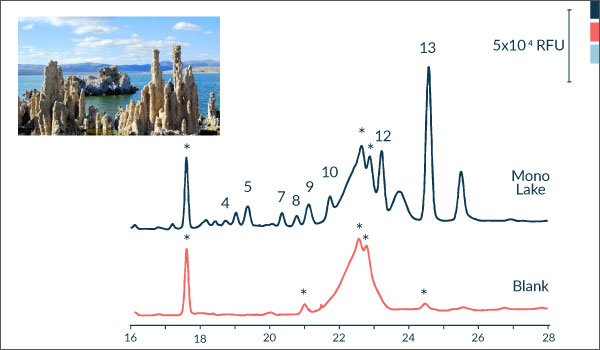Above:
Signatures of life on other worlds can come from distributions of amino acids encountered in samples. At MDL we have developed new methods and proved them by detecting life in samples collected from Mono Lake, California, a known astrobiology analogue location.
Biosignatures
Amino Acid Biosignature Detection
Peter Willis - Jessica Creamer - Fernanda Mora
While extraterrestrial life may exist, there is no telling what form it will take, or whether it will use the same “alphabet” of biomolecules as life on Earth. To increase the chances of finding evidence for alien lifeforms elsewhere in the solar system, we need life-detection strategies that can provide quantifiable evidence for life at the molecular level. One such strategy is to look for patterns of properties possessed by organic molecules within a given inventory.[1]
For example, distributions of three amino acid characteristics: type, relative abundance, chirality can be used as biosignatures to indicate the presence of life (Figure 1) and as used in the
OWLS project
[2]. The benefit of this approach is that amino acids are also formed through abiotic processes, so even in the absence of life, it is possible to gain useful information about the chemistry of the environment. However, the in situ analysis of amino acids poses challenges due to expected low abundance in extreme environments. In order to search for amino acid biosignatures it is necessary to develop in situ analytical instrumentation capable of a selectivity and sensitivity.[3]
Capillary electrophoresis (CE) is an ideal candidate for in situ science missions, especially to areas where aqueous analysis is required. CE is a liquid-based technique capable of high efficiency separations of a wide variety of molecules and, when coupled to Laser Induced Florescence (LIF), it can achieve sub-part-per-billion limits of detection. Recently, our lab developed a chiral CE–LIF method for the simultaneous separation of the 13 most astrobiologically relevant amino acids (including five chiral pairs) required to detect three unique biosignatures.[2]
The background electrolyte for this method is composed of sodium tetraborate, to maintain the pH at 9.2,as well as two chiral selectors sodium taurocholate and γ-cyclodextrin, and 5% acetonitrile to adjust the viscosity and polarity. Finally, to achieve low limits of detection with LIF, the assay requires 5-carboxy fluorescein succinimidyl ester (CFSE) to label the amino acids prior to separation. To help qualify this method for spaceflight, these chemical reagents have undergone thorough radiation and temperate stability testing.[4, 5]
An important feature of this CE-LIF assay is that high salinity samples can be analyzed by this method with minimal sample preparation. The hypersaline lake water samples were analyzed by simply mixing 1:1 with a tetraborate buffer and then adding the CFSE dye for derivatization. No desalting or preconcentration was necessary.
For more information, see the paper in the journal, Electrophoresis [4], from which much of this material was taken.
[1] Lovelock, J. E., Nature 1965, 207, 568-570.
[2] Creamer, J. S., Mora, M. F., Willis, P. A., Analytical Chemistry 2017, 89, 1329-1337.
[3] Willis, P. A., Creamer, J. S., Mora, M. F., Anal. Bioanal. Chem. 2015, 407, 6939-6963.
[4] Creamer, J. S., Mora, M. F., Willis, P. A., Electrophoresis 2018, 39, 2864-2871.
[5] Creamer, J. S., Mora, M. F., Willis, P. A., Electrophoresis 2019, In preparation
Signatures of life on other worlds (such as Europa, pictured at lower right) can come from distributions of amino acids encountered in samples, by using capillary electrophoresis (raw data shown at lower left). Using our methods we have detected all three biosignatures mentioned above in samples collected from Mono Lake, California, a known astrobiology analogue location.
+ Larger image
The 12 most common amino acids found in abiotic (meteorites) and biotic (E. coli) samples, presented in a Venn diagram that highlights the overlap of these amino acids between biotic, proteinogenic, and abiotic classifications (Left). Relative abundance of the proteinogenic amino acids with respect to Gly.
+ Larger image
Separation data (time vs fluorescence signal) of the CE-LIF analysis for the Mono Lake sample compared to the blank. Amino acid concentrations were 50-200 nM. Peaks: (4) L-His, (5) L-Leu, (7) GABA, (8) L-Val, (9) D-Ala, (10) L-Ser, (12) L-Ala, (13) Gly; *Dye side products.
+ Larger image





